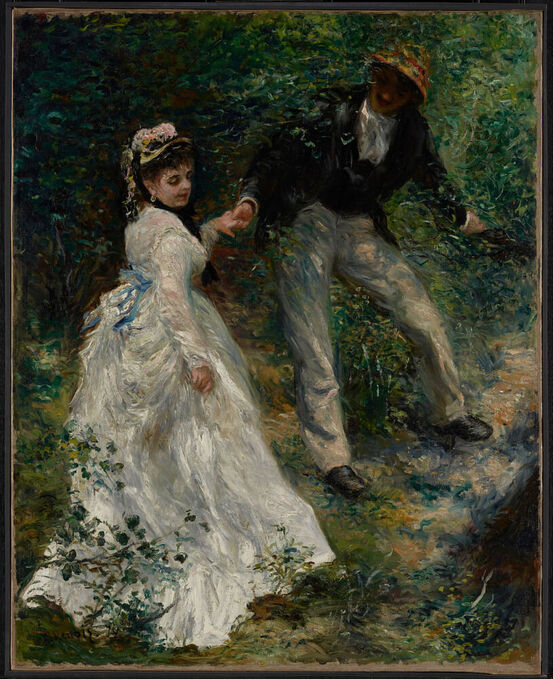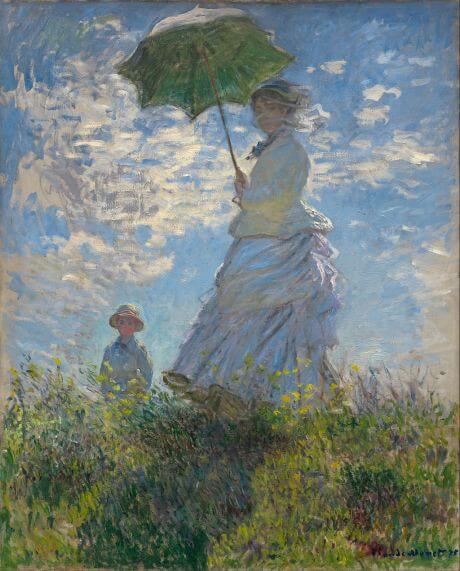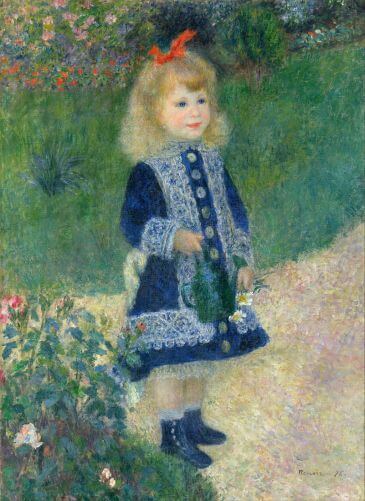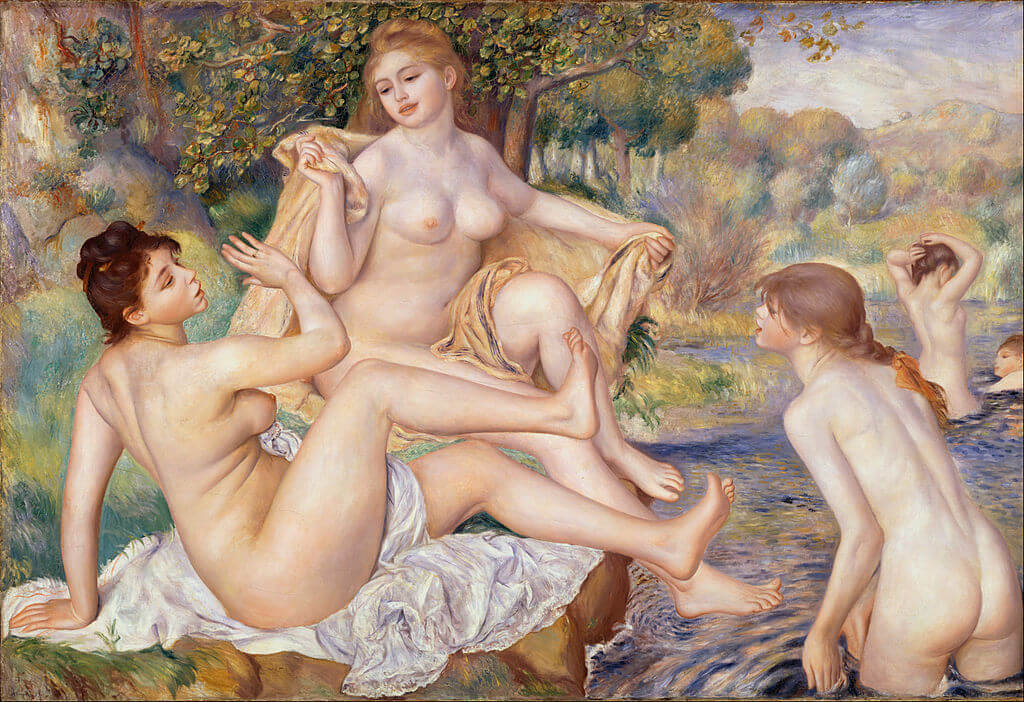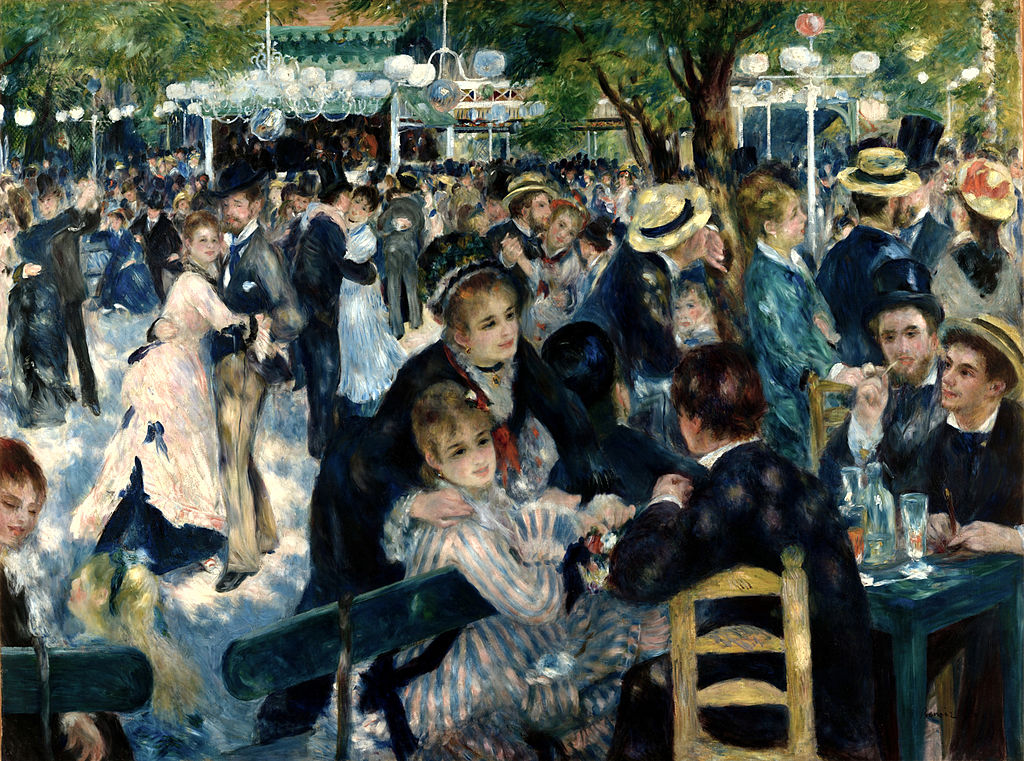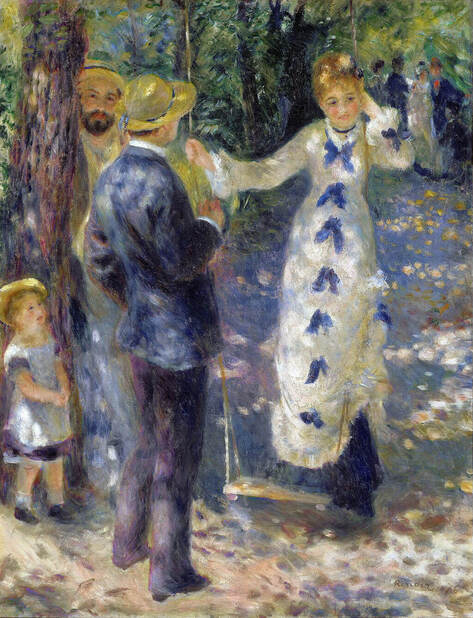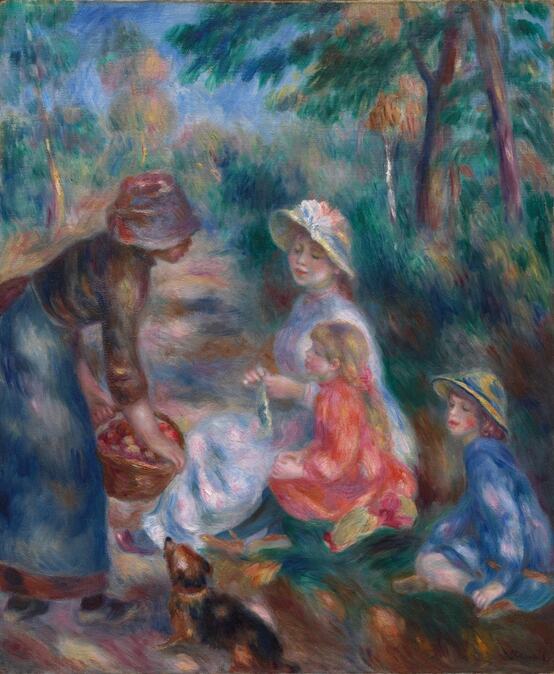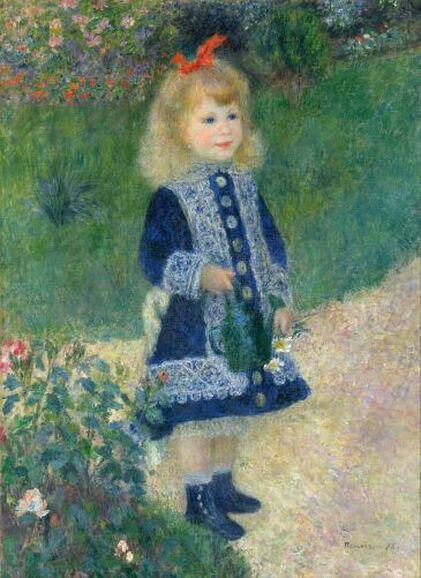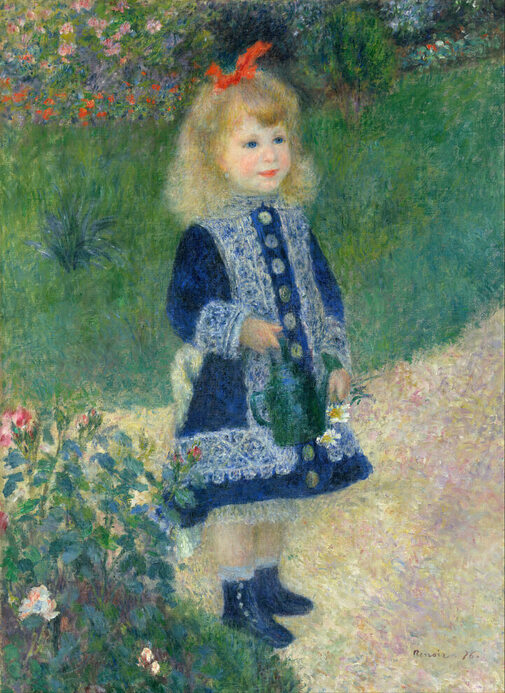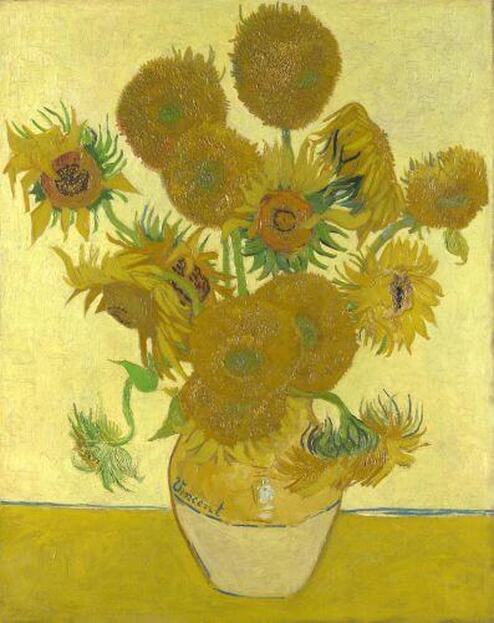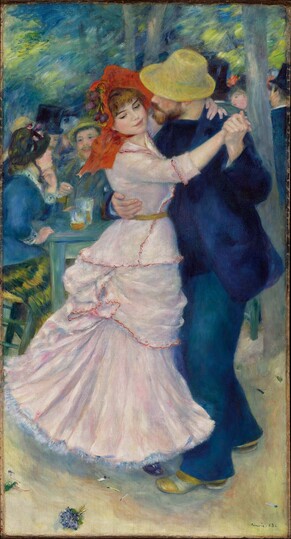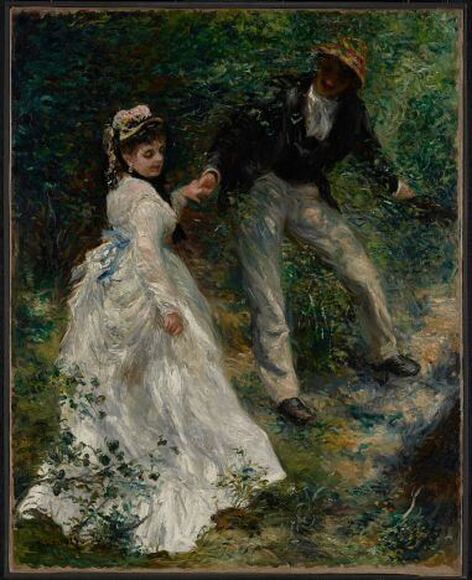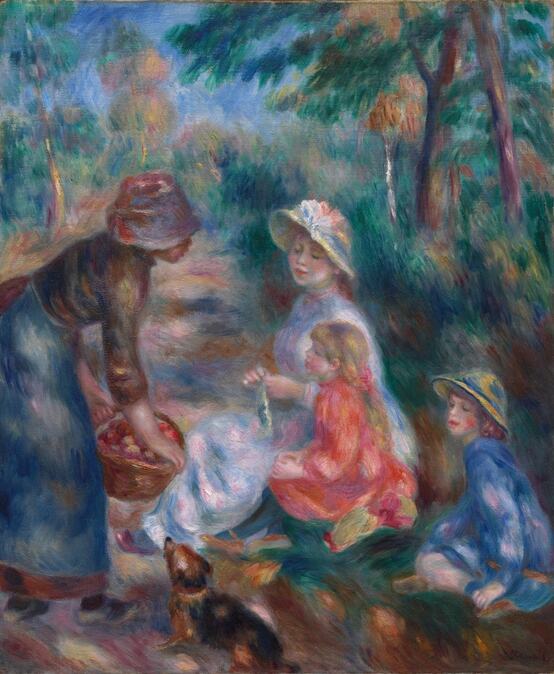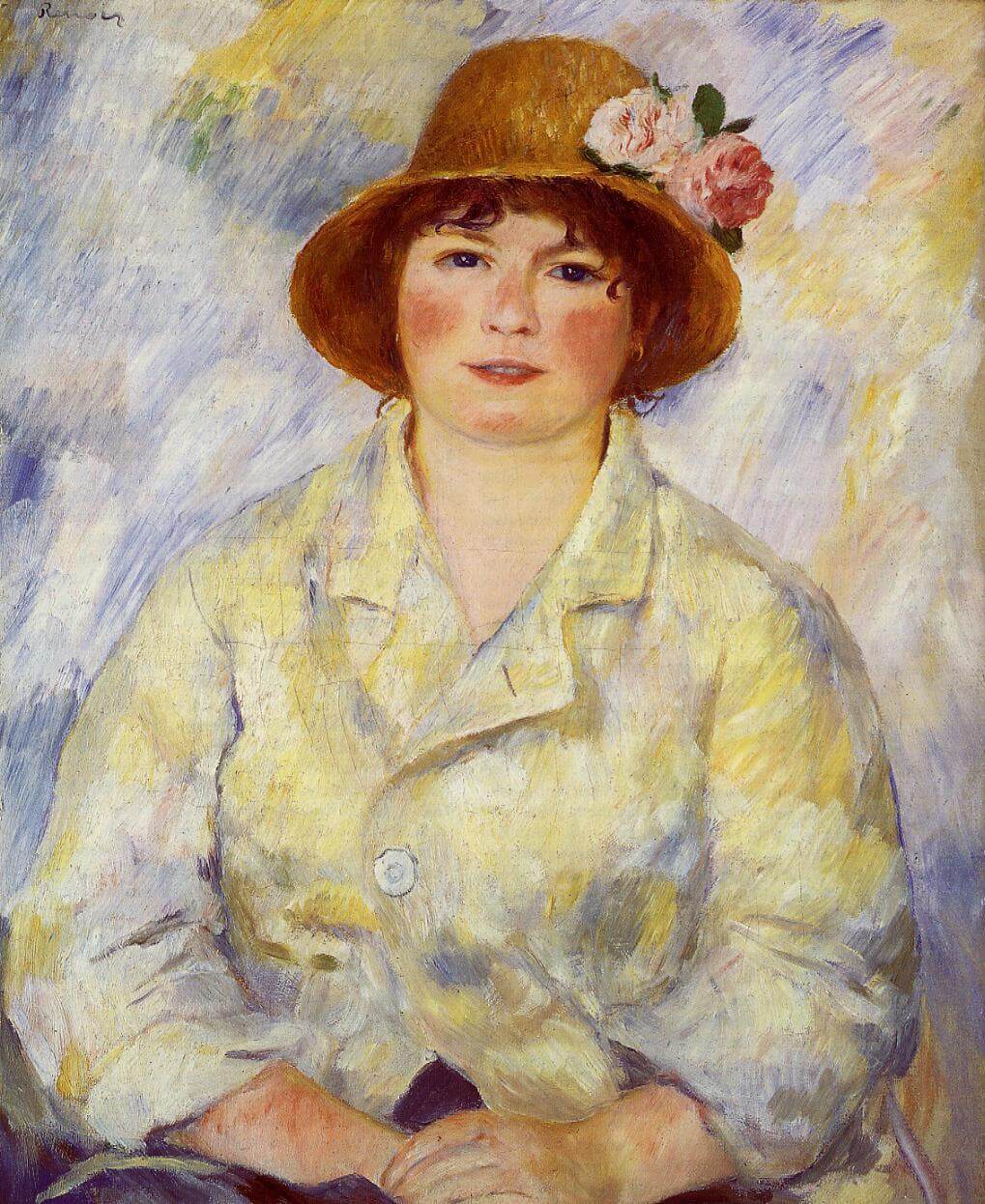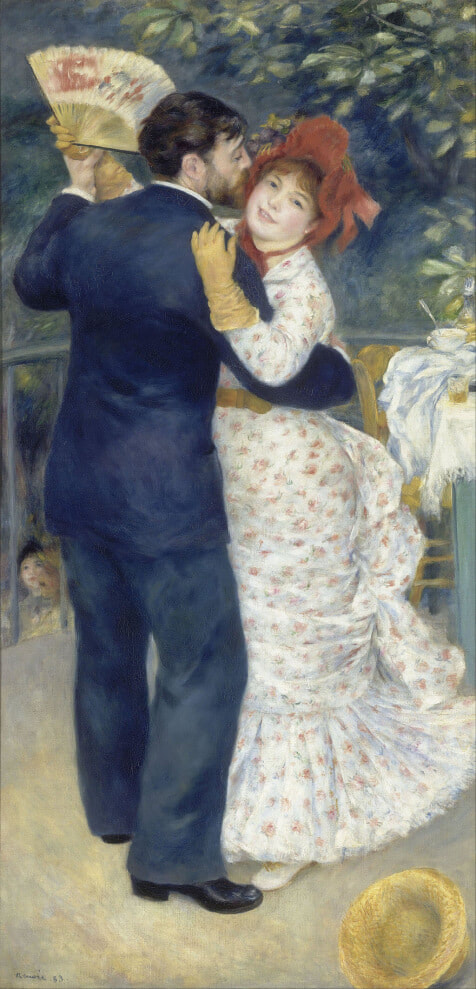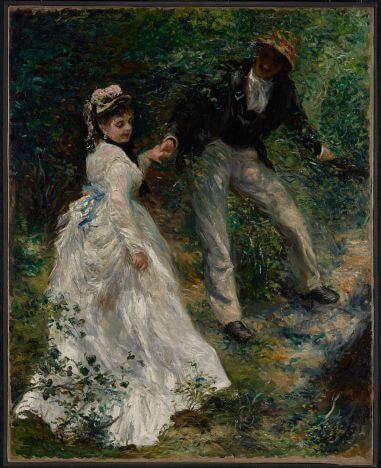|
Where? Room W204 of the J. Paul Getty Museum
When? 1870 What do you see? Two well-dressed people are depicted in a green landscape, probably a forest or park near Paris. On the left is a somewhat shy woman in a long white dress (no, the white dress is not stained like an art critic from that time said, but it is the trademark Impressionist painting style). he man on the right wears a somewhat informal, but neat set of clothes and a brown hat with a red ribbon around it. He holds the hand of the woman to guide her through the dense, uncultivated terrain. With his left arm, he pushes the bushes aside such that they can continue on the small path they are walking. The woman slightly lifts her white dress and has her head turned over her right shoulder as if she is hesitant to continue down the path. There seems to be some love connection between the two. The couple is enjoying a relaxed stroll through the landscape, and the painting technique of Renoir makes them blend into the landscape. Renoir used the light in this painting to emphasize the presence of the woman and the path through the forest. The man is standing in the shadow and only parts of his pants, hands, collar, and hat capture some sunlight. Backstory: In 1989, the Getty Museum paid $17.7 million to acquire this painting. The title of the painting is La Promenade, which means ‘the walk’. However, it is not certain whether Renoir gave this title to the painting or whether it was given later on by auctioneers. This painting is a direct result of his interactions with Claude Monet, who had advised him in 1869 to use lighter colors. Monet himself also used lighter colors, and you can see some of the similarities between this painting by Renoir and Woman with a Parasol - Madame Monet and Her Son by Monet in 1875, which is in the National Gallery of Art.
The birth of Impressionism: In the 1860s, in France, the government and the powerful art institutions were in control of the type of art that was exhibited. The artists paid a lot of attention to the details and finish of their works. Under the lead of Édouard Manet, a group of artists changed their style to what we now call Impressionism. Manet hosted a twice-weekly meeting with painters such as Cézanne, Degas, Monet, Pissarro, Renoir, and Sisley.
Among other things, the Impressionists wanted to capture quick, transitory moments in time. To do that, they changed the technique of painting. Before, different layers of paint were applied on top of each other, with long waiting times in between each layer to make sure each layer dried properly. Impressionists, however, wanted to paint their observations in a single session and had to immediately apply the right color of paint to the canvas as they could not resort to the underlying layers to create the perfect color. Who is Renoir? Pierre-Auguste Renoir (1841-1919) was a French impressionist artist. He is often referred to simply as Auguste Renoir and he also signed this painting with A. Renoir. He was a talented singer and wanted to become a professional singer when he was young. However, as singing was a risky career, he switched to painting in which he was also talented. His early work was inspired by Manet and Pissarro, and by his friend and contemporary, Claude Monet. By 1879, Renoir was considered to be a successful painter, and he took some time to travel around Europe and North Africa to become familiar with the works of Delacroix, Raphael, Titian, and Velázquez. Some of his famous works include A Girl with a Watering Can in the National Gallery of Art and The Large Bathers in the Philadelphia Museum of Art.
Fun fact: The man is this painting is probably Alfred Sisley, a British impressionist painter who lived most of his life in France. Sisley was a friend of Renoir. They met in art school in Paris in 1862.
The model for the woman in this painting is probably Lise Tréhot. She had a relationship with Renoir and served as a female model for almost all his paintings between 1866 and 1872. While not a lot is known about the exact nature of their relationship, they may have gotten two children together. The first may have died as an infant. In 1868 Lise gave birth to a girl, Jeanne, who was given away to a nurse. Indirect evidence that this was the child of Renoir as well is that he secretly provided financial support to Jeanne during his life, even though he has never publicly acknowledged her as his child. Interested in a copy for yourself? Poster
0 Comments
Where? Room 31 of the Musée d'Orsay
When? 1876 What do you see? An open-air dance in Montmartre (a hill and district in Paris). On the table in the foreground sits a 16-year old model in a striped dress. Her name is Estelle. Probably, her older sister, Jeanne Samary, stands behind her and is in conversation with the painter Franc Lamy. Renoir used Jeanne Samary more often as a model for his paintings, such as in The Swing which is also in the Musée d’Orsay. The man on the right side of the other side of the table is George Rivière, the biographer of Renoir, and the man smoking a pipe on the left is the printmaker Norbert Goeneutte. Behind the seated people in the foreground, people are dancing under the acacia trees. The dancing women are mainly local people, and the men are mostly friends of Renoir. On the bottom left, a child is playing with her mother. This painting may be painted on a Sunday afternoon when the dance hall was open to families with children. On the top, we can identify some chandeliers that are hanging in the trees, as well as some lights on a pole on the right.
The effects of light: Renoir paid careful attention to the effect of the sunlight on the dancing people. It seems to be a sunny day, but the trees block part of the sunlight. We can see the brighter and darker areas in the painting by looking at the ground and the colors of the dresses of the woman. Look also at the man sitting with his back toward us in the right foreground. He has some light patches on his jacket and head. This is the result of the sunlight shining through the trees.
Backstory: This painting is also known as ‘Bal du Moulin de la Galette’ and ‘Au Moulin de la Galette.’ Moulin de la Galette was the name of a neighborhood dance hall located next to a windmill (moulin is French for windmill). Renoir also painted a smaller version of this painting which is in a private collection. In that version, he leaves out more details. This painting was sold in 1990 for $78.1 million, which is still a record for a Renoir painting. It is uncertain which of the two versions has been painted first. The current version is in the Musée d’Orsay since 1986 when it was transferred from the Louvre. Renoir used loose brush strokes to paint this work, and the painting lacks quite some detail. On the Impressionist exhibition where this painting was first shown to the public, some people were confused and thought that Renoir did not finish his painting yet. However, Renoir left out many details on purpose as he understood that the human eye could fill in the details when looking at the painting. This allowed him to focus on the effects of light and movement, and create a bright and happy painting of the public dance. Open-air dance halls? The Moulin de la Galette was an open-air dance hall in Paris in the 1870s. Open-air dance halls were very popular in 19th-century France and were a great source of entertainment for the people. Most people went there not to dance, but just to watch the dancers and enjoy the relaxed atmosphere. Renoir is the only Impressionist artist to depict this theme in his paintings. Renoir attended most of the events at the Moulin de la Galette, sometimes accompanied by other artists like Degas, and liked to dance there as well. To watch the dancers at the Moulin de la Galette, you had to pay a quarter French franc. The Moulin de la Galette first opened around 1833. Who is Renoir? Pierre-Auguste Renoir (1841-1919) is a French painter from Limoges in the middle of France. When Pierre-Auguste was three years old, his family moved to Paris where they lived close to the Louvre. It was a dream of him to have his work on display in the Louvre and in the last year of his life, he visited the Louvre where he could see his own work hanging among the masterpieces that he admired as a child. Renoir is one of the founders of Impressionism, together with artists like Cézanne, Degas, Manet, and Monet. The Impressionists focused on the effects of light and often painted outside. Renoir’s opinion about art was that it should be pretty and he mostly painted very happy scenes. Two good examples are The Apple Seller in the Cleveland Museum of Art and A Girl with a Watering Can in the National Gallery of Art.
Fun fact: Renoir painted an open-air dance in Montmartre, a neighborhood in Paris that was popular among artists in the second half of the 19th century. It was the home to artists like Degas, Manet, Monet, Picasso, and Van Gogh. Renoir lived there as well and rented a studio close to the dance hall depicted in this painting. He brought the canvas from his studio to the dance hall to paint the dance. Many people that he knew participated in the dance. The story goes that, on some days, when it was windy, some of his friends there had to help him to keep the canvas straight while he was painting.
Interested in a copy for yourself? Poster or canvas
Where? Gallery 85 of the National Gallery of Art
When? 1876 Commissioned by? Possibly for the art collection of Baron Achille Sellière What do you see? A young and pretty girl holds a green watering can in her right hand and two daisies in her left hand. She is probably around four years old and wears a knee-length, deep blue dress with extensive white lace on it. She also wears matching blue boots with white lace on the top. She has red lips, blue eyes, and rosy cheeks. She has a red bow in her long curly blonde hair. She seems to be content while watering the flowers. The girl stands on a light-colored footpath in the garden. The colors that Renoir used for the stones and dirt on the footpath contrast nicely with the green grass surrounding it. On the bottom left are a rose bush and some grass. In the background is more grass and a collection of flowers. In this painting, you can clearly see that Renoir applied the colors with individual touches and that he did not mix them on the canvas. This technique is typical of the Impressionist art style. No Shadow: Interestingly there is no shadow visible anywhere in this painting. The reason is that Renoir wanted to create an illuminating painting where the light radiates from the painting as soon as you see it. This painting is a good example of a painting that stands out from the rest of the paintings in the room in the National Gallery of Art. Another example of such an illuminating painting is Sunflowers by Van Gogh. You can see one of the versions of this painting in the Philadelphia Museum of Art and this painting also clearly stands out from the other paintings in the room. Another version is in the National Gallery in London. It is, however, also surprising that Renoir did not include a shadow in this painting, as he famously said: "No shadow is black. It always has a color. Nature knows only colors … white and black are not colors."
Backstory: According to some, this painting has been created in the garden of Claude Monet in Argenteuil, France, but this is not certain. The girl in this painting is probably a girl that lived near Renoir, possibly called Mademoiselle Leclere. He picked her because of her prettiness and especially her distinctive eyes.
This painting is a classical Impressionist painting as it focuses on the different colors and how they can be used to represent the effects of sunlight. Like many other Impressionist paintings, this work was painted while Renoir was outside (something that was uncommon in the period before Impressionism). However, at the same time, the simplicity of this painting is a first step in the direction of Post-Impressionism which is famous because of artists like Van Gogh. Who is Renoir? Pierre-Auguste Renoir (1841-1919) was a French impressionist painter. When he was three years old, his family moved to Paris and lived close to the Louvre. As a child, he often visited the Louvre to admire works of art. He developed himself into one of the best Impressionist painters and nowadays you can find some of his work in the Musée d'Orsay. Together with people like Manet, Monet, and Pissarro, he is one of the founders of the Impressionist art style. Renoir said that he painted for fun and painted scenes “which made me want to walk in it.” He continued to enjoy painting until the end of his life, even after he had developed arthritis and it became difficult to hold a brush. Some of his other great works include Dance at Bougival at the Museum of Fine Arts in Boston and La Promenade in the Getty Museum.
Fun fact: At the time of this painting, Renoir was still in a struggle for money. To generate money, Renoir decided to paint widely attractive scenes of women and children in the hope that these would sell more easily and possibly attract some commissions for portraits. These kind of scenes were in high demand in France at that time. His strategy paid off as by 1879 he had become a successful painter with some money which he used to travel around Europe and North Africa.
Interested in a copy for yourself? Poster or canvas.
Where? Gallery 222 of the Cleveland Museum of Art
When? Around 1890 What do you see? On the left, a girl from the country tries to sell apples to Aline Charigot, the wife of Renoir, and two kids. Aline Charigot wears a long light-colored dress, with hints of blue, white, and pink. She wears a hat with a fancy ribbon around it that matches her dress. The boy on the right is the nephew of Renoir, called Edmond. He wears a blue outfit with a blue and yellow hat. It is unknown who the girl in the red dress and the red bow in her hair is. The hat of the girl lays next to her. The apple seller wears a simple outfit with plain colors to indicate her relatively low status. She wears a country hat which largely covers her face and bends forward to show the apples. It seems that she is asking Aline Charigot whether she wants to buy some fresh apples for the kids. In the foreground is a small dog and we can see the contours of a forest in the background. Renoir used very light brushstrokes that are clearly visible on the canvas. This technique creates a unique combination between the light and colors in this painting. Backstory: Renoir created this painting during one of the summers which he spent in the small village, Essoyes, about 125 miles (200 km) Southeast of Paris. This village was the birthplace of his wife and they later also bought a house there. Renoir and Aline Charigot got married around this time, and Renoir may have painted this on their honeymoon. Who is Aline Charigot? Aline Charigot (1859-1915) was born in a small village, Essoyes, in France. She met Renoir in 1880 and started modeling for him. However, they soon got into a relationship with each other, and in 1885 they got their first son together. Renoir painted a portrait of Aline Charigot shortly after the birth of their son, which is now in the Philadelphia Museum of Art. He kept this portrait of her until his death. In 1890, they married. Aline Charigot modeled for at least 20 paintings of Renoir. For example, she is the woman in Dance in the Country in the Musée d’Orsay which Renoir painted in 1883.
Symbolism: While Renoir did not like to include symbolism in his paintings, there seems to be one clear contrast that he wanted to emphasize here. This is related to the contrast in the clothes of the apple seller, and the woman and children on the right. Whereas, the apple seller wears plain clothes with dull colors, the wife of Renoir and the two kids are dressed in fancy outfits. Renoir shows here the difference between the lower and upper-class people in 19th century France because he wanted to depict his wife and the two kids as part of the upper class of society.
Who is Renoir? Pierre-Auguste Renoir (1841-1919) was one of the leading French Impressionist painters. He mainly created colorful paintings of subjects and scenes that he enjoyed, such as scenes with leisure activities, and woman and children. So, most of his paintings do not contain a deeper message. Renoir got inspired by artists such as Degas, Delacroix, Manet, and Rubens. Some of his great works include A Girl with a Watering Can in the National Gallery of Art and La Promenade in the Getty Museum. The latter painting is another good example of a painting in which Renoir integrated his subjects with nature, just like he does in the current painting of the apple seller.
Fun fact: Renoir used quick and long brush strokes, combined with soft colors, to create this painting. He used a separate brush for each color that he used to make sure that he used pure colors for his brush strokes. You can clearly see the long vertical brush strokes in this work. He creates an effect where the scene seems out of focus. Especially, the forest in the background seems blurry, which helps the viewers to focus on the people in the foreground. When you observe the painting from a distance, the content becomes more clear.
|
Categories
All
|
- Home
- Blog
-
Museums
- Alte Pinakothek
- Art Institute of Chicago
- Baltimore Museum of Art
- Barber Institute of Fine Arts
- Bargello
- Barnes Foundation
- British Museum
- Church of Sant’Anastasia
- Cleveland Museum of Art
- Courtauld Institute of Art
- Detroit Institute of Arts
- Frans Hals Museum
- Galleria Borghese
- Gallerie dell'Accademia
- Getty Museum
- Guggenheim
- Hermitage Museum
- Kunsthistorisches Museum
- Kunstmuseum Basel
- Legion of Honor Museum
- Louvre
- Mauritshuis
- Metropolitan Museum of Art
- Musee d’Orsay
- Museum of Fine Arts in Boston
- Museum of Modern Art
- National Gallery in London
- National Gallery of Art
- National Museum in Poznań
- Norton Simon Museum
- Ny Carlsberg Glyptotek
- Palace of Versailles
- Palazzo Pitti
- Palazzo Vecchio
- Petit Palais
- Philadelphia Museum of Art
- Prado
- Pushkin Museum
- Ravenna Art Museum
- Rijksmuseum
- San Diego Museum of Art
- Santa Maria delle Grazie
- St. Peter's Basilica
- Städel Museum
- Statens Museum for Kunst
- Tate Britain
- Tate Modern
- Timken Museum of Art
- Uffizi
- Vatican Museums
- Wallace Collection
-
Artists
- Altdorfer
- Anguissola
- Berlin Painter
- Bosch
- Botticelli
- Boucher
- Bronzino
- Bruegel the Elder
- Brunelleschi
- Cabanel
- Caillebotte
- Canova
- Caravaggio
- Carpeaux
- Cezanne
- Cimabue
- David
- Degas
- Delacroix
- De Maria
- Donatello
- El Greco
- Fontana
- Fra Angelico
- Fragonard
- Gauguin
- Gentileschi
- Gericault
- Gonzalez-Torres
- Goya
- Hals
- Hogarth
- Hokusai
- Ingres
- Leonardo da Vinci
- Lippi, Filippo
- Longhi, Barbara
- Lorrain
- Makovsky
- Manet
- Massys
- Matisse
- Merian
- Michelangelo
- Mochi
- Modigliani
- Monet
- Panini
- Parmigianino
- Perugino
- Picasso
- Pisanello
- Raphael
- Rembrandt
- Renoir
- Reynolds
- Rivera
- Rodin
- Rubens
- Scultori
- Seurat
- Steen
- Tintoretto
- Titian
- Toulouse-Lautrec
- Turner
- Uccello
- Van der Weyden
- Van Dyck
- Van Eyck
- Van Gogh
- Van Hemessen
- Vasari
- Velazquez
- Vermeer
- Veronese
- Vigée Le Brun
-
Locations
- Books
- About Us

